Error E22 in Hansa washing machine
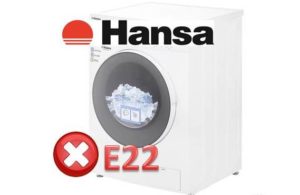 Error E22, which suddenly appears on the display of the washing machine, will certainly raise a lot of questions from the user. What happened to the machine, what to do in this situation, what does the code indicate? In most cases, it speaks of some short-term failure that occurred in the system. It is enough to disconnect the device from the network and start it after 15-20 minutes. But if error E22 is displayed even after this, there is a breakdown of the Hans washing machine, which should be fixed. Which one exactly – we’ll find out together.
Error E22, which suddenly appears on the display of the washing machine, will certainly raise a lot of questions from the user. What happened to the machine, what to do in this situation, what does the code indicate? In most cases, it speaks of some short-term failure that occurred in the system. It is enough to disconnect the device from the network and start it after 15-20 minutes. But if error E22 is displayed even after this, there is a breakdown of the Hans washing machine, which should be fixed. Which one exactly – we’ll find out together.
What happened to the machine?
The fault code issued by the automatic washing machine limits the range of possible breakdowns. The alphanumeric combination displayed on the display allows the user to independently understand the cause of the violation. Error E22 indicates a problem with the washing machine motor. That is, it was the engine that failed, neither the wiring, nor the tachometer, nor other elements of the machine. Very rarely, such a code appears when the triac on the main control board breaks down, but such cases are rare. So what to do when an error appears?
- Check the washing machine motor for breakdowns.
- When the unit is equipped with an electric motor with a belt drive, analyze the condition of the brushes. If they have recently been replaced, check to see if they were installed correctly.
- Examine the manifold; it may need cleaning.
In this case, it is possible to fix the breakdown yourself, without resorting to the help of specialists. To make repairs yourself, you need to figure out what the root cause of the error is. E22.
Detailed motor check
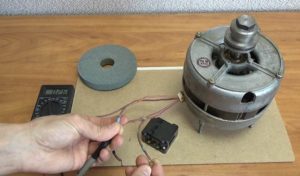 Automatic machines of the Hansa brand are equipped with commutator motors, which involve some inconvenience during operation. In motors of this type, lamellas and brushes break, and the winding periodically breaks through. As you can see, there are enough reasons for engine failure. But to understand what exactly happened to the motor, you need to get to it:
Automatic machines of the Hansa brand are equipped with commutator motors, which involve some inconvenience during operation. In motors of this type, lamellas and brushes break, and the winding periodically breaks through. As you can see, there are enough reasons for engine failure. But to understand what exactly happened to the motor, you need to get to it:
- unfasten the back wall of the washing machine;
- carefully disconnect the wiring from the motor;
- Unscrew the mounting bolts and remove the engine from the housing.
When the part is in your hands, start diagnosing the engine. The stator and rotor winding wires are connected to each other. Next, the created connection is connected to a 220 V electrical network. If the rotor rotates, then the device is functioning properly. However, this diagnostic method has its drawbacks:
- it is impossible to completely confirm the performance of the engine, especially its functioning in various washing modes;
- when the engine is directly connected to the network, there is a possibility that it may simply short-circuit.
Therefore, it is best to add ballast to the created circuit, which will serve as protection for the motor. A heating element from a machine is perfect for this. Connect the elements based on this diagram:
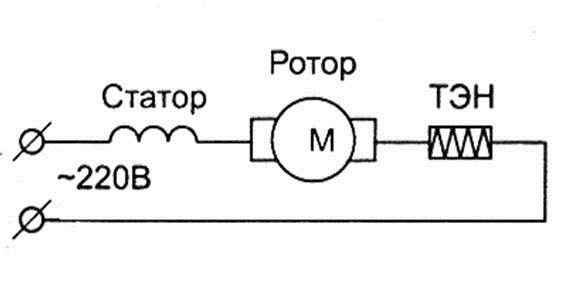
By fastening the winding wires in this way, you will ensure the safety of the engine; when closed, the heating element will heat up, protecting the motor from combustion. Having studied the structure of the collector engine, you can see that it has several components. To understand what is causing the DTC, all parts should be checked.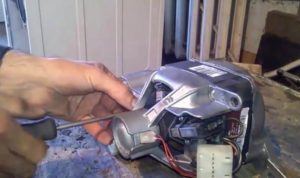
- Electric brushes. They are located on the sides of the engine. Inspect them, if the elements are worn out, replace them. It is not difficult to understand that the problem lies in the brushes.Connect the motor wiring to the electrical network; if the engine sparks, that’s the problem. You can purchase replacement brushes at a specialized store by telling the manager the SMA model.
- Lamels. Through these elements, electricity is directed to the rotor. The lamellas are attached to the shaft with glue, so they tend to peel off. Small delaminations can be removed using a lathe (carefully turning the commutators). When inspecting the lamellas, pay attention to any peeling, they will indicate a malfunction of the motor.
- Rotor and stator winding. If there are problems with the winding, the washing machine motor will not be able to work at full capacity or will fail altogether. When a short circuit occurs in it, the engine overheats. The thermistor automatically turns off the motor for safety reasons. To diagnose the winding you will need a multimeter. The device switches to resistance determination mode, the multimeter probes are applied to the lamellas. Normally, the screen should display an indicator in the range from 20 to 200 Ohms.
If the resistance value does not reach the normal limits, a short circuit occurs; if it exceeds them, it can be stated that the winding is broken.
You should also check the starter with a multimeter. Select the buzzer mode, and apply the probes to the wires one by one. When the tester is silent, everything is fine. If the device makes sounds, look for the short circuit by applying one probe to the body of the part, the second to the wiring.
Once the defect is detected, the breakdown should be repaired. If the problem is in the brushes, replace them; it makes sense to treat the lamellas. There is no point in trying to restore the winding; it is better to purchase a new motor.
Interesting:
Reader comments
- Share your opinion - leave a comment


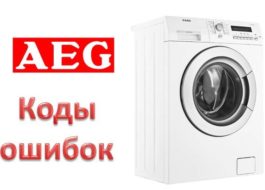
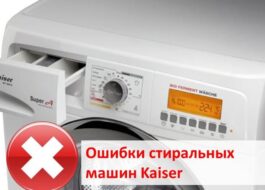
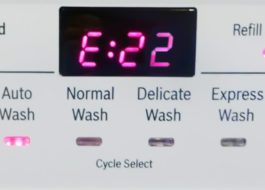
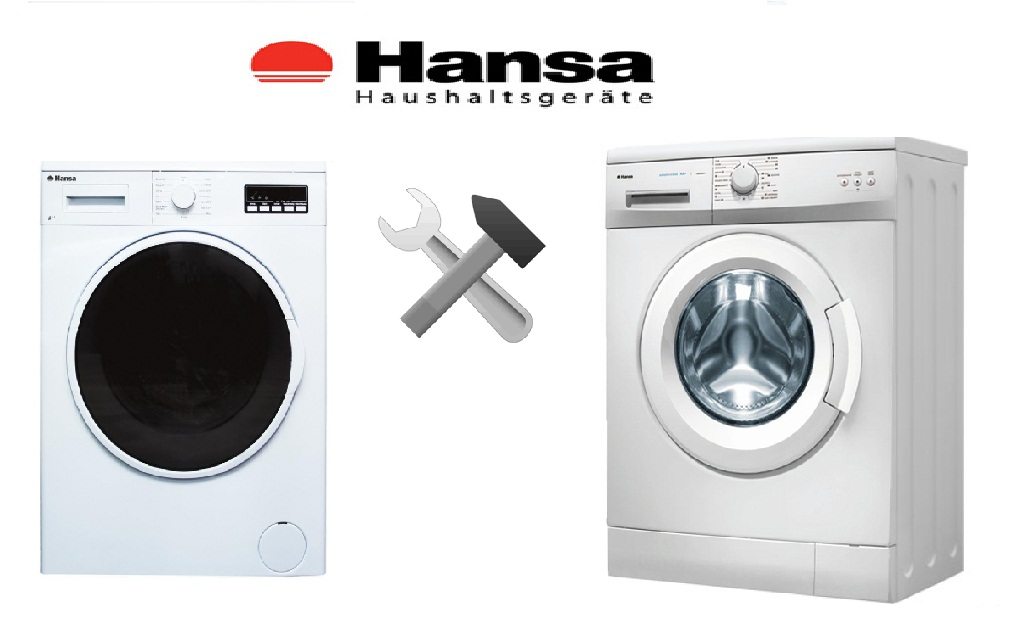
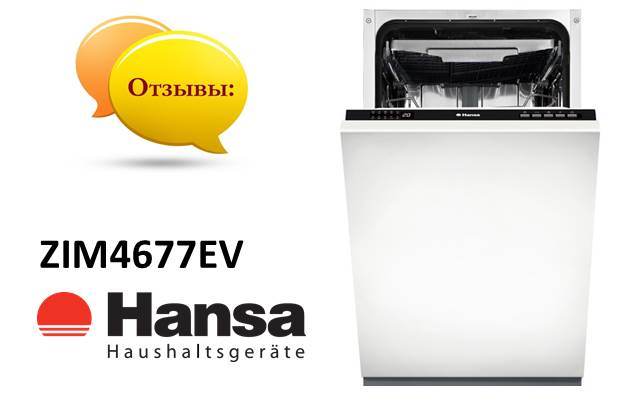














Add a comment